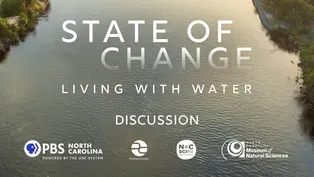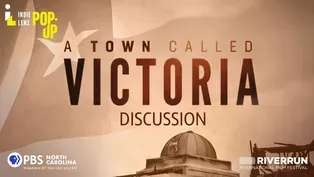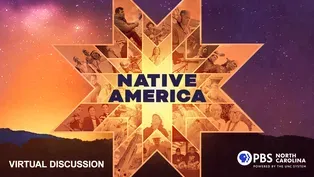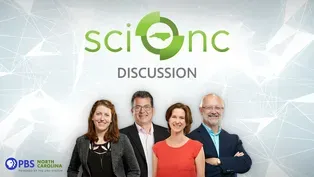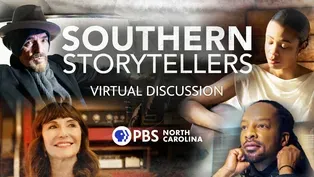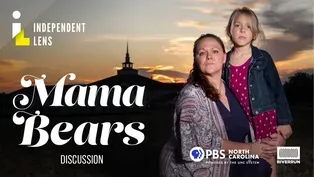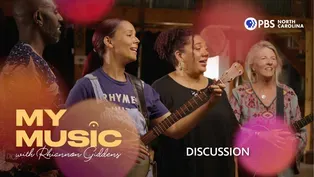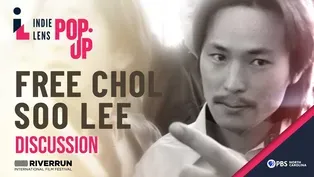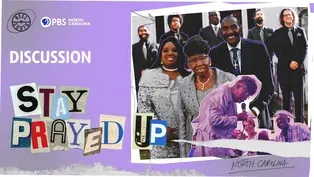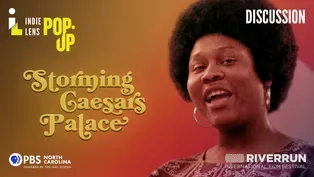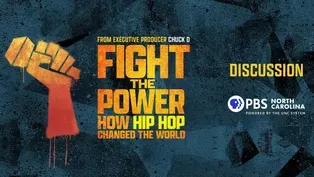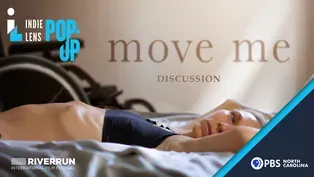PBS North Carolina Specials
Discussion - Love in the Time of Fentanyl | Independent Lens
1/24/2023 | 55m 44sVideo has Closed Captions
Local harm reductionists, therapists and others discuss the opioid crisis and more.
PBS NC's Shannon Vickery leads a conversation about drug use and harm reduction. Our panelists: Loftin Wilson, programs manager at NC Harm Reduction Coalition, Hill Brown, Southern director at Faith in Harm Reduction, Leah Wright, founder of Wake Monarch Academy and Justin Garrity, MSW, LCASA, director of recovery services, Healing Transitions. The conversation was translated by ASL interpreters.
Problems with Closed Captions? Closed Captioning Feedback
Problems with Closed Captions? Closed Captioning Feedback
PBS North Carolina Specials is a local public television program presented by PBS NC
PBS North Carolina Specials
Discussion - Love in the Time of Fentanyl | Independent Lens
1/24/2023 | 55m 44sVideo has Closed Captions
PBS NC's Shannon Vickery leads a conversation about drug use and harm reduction. Our panelists: Loftin Wilson, programs manager at NC Harm Reduction Coalition, Hill Brown, Southern director at Faith in Harm Reduction, Leah Wright, founder of Wake Monarch Academy and Justin Garrity, MSW, LCASA, director of recovery services, Healing Transitions. The conversation was translated by ASL interpreters.
Problems with Closed Captions? Closed Captioning Feedback
How to Watch PBS North Carolina Specials
PBS North Carolina Specials is available to stream on pbs.org and the free PBS App, available on iPhone, Apple TV, Android TV, Android smartphones, Amazon Fire TV, Amazon Fire Tablet, Roku, Samsung Smart TV, and Vizio.
Providing Support for PBS.org
Learn Moreabout PBS online sponsorshipMore from This Collection
Discussion - State of Change: Living with Water
Video has Closed Captions
Panelists discuss resilient North Carolinians adapting to climate change. (28m 54s)
Discussion - A Town Called Victoria - Independent Lens
Video has Closed Captions
The filmmaker and former Victoria residents share their story. (46m 51s)
Discussion - Native America Season 2
Video has Closed Captions
Panelists discuss preserving the languages of Native American tribes. (39m 1s)
Video has Closed Captions
Sci NC executive producer and host, Frank Graff, chats about upcoming Season 6 of Sci NC. (26m 6s)
Discussion - Southern Storytellers
Video has Closed Captions
Author David Joy and others discuss storytelling and their new PBS series. (42m 13s)
Discussion - Mama Bears | Independent Lens
Video has Closed Captions
Producer and director Daresha Kyi discusses the film and LGBTQIA+ advocacy. (34m 41s)
Discussion - My Music with Rhiannon Giddens
Video has Closed Captions
Discussing the series with producers Will & Deni McIntyre and country artist Rissi Palmer. (39m 56s)
Discussion - Free Chol Soo Lee | Independent Lens
Video has Closed Captions
Local lawyers, professors and nonprofit leaders discuss wrongful convictions and reentry. (40m 44s)
Discussion - Stay Prayed Up, Reel South
Video has Closed Captions
The filmmakers discuss their journey with Mother Perry and The Branchettes. (45m 4s)
Discussion - Storming Caesars Palace | Independent Lens
Video has Closed Captions
Local professors and nonprofit leaders discuss welfare and the social safety net. (33m 2s)
Discussion - Fight the Power: How Hip Hop Changed the World
Video has Closed Captions
Local experts discuss the history of hip hop with PBS North Carolina. (59m 43s)
Discussion | Independent Lens: Move Me
Video has Closed Captions
A dancer with blindness and disability advocates discuss adaptable arts programs. (38m 46s)
Providing Support for PBS.org
Learn Moreabout PBS online sponsorship- Hello everyone, and good evening.
I'm Shannon Vickery, Director of Corporate Engagement here at PBS North Carolina.
Welcome and thank you for joining us for such an important film and conversation.
Tonight we gather to discuss a very sensitive and important group of topics.
Drug use and abuse, prevention, treatment, rehab options and protocols, available resources and harm reduction.
If at any time during the discussion it gets too upsetting or triggering for you, please take a moment to mute your microphone or step away.
Tonight we want to provide a safe space for an open and informative community-driven discussion.
Please be respectful when entering your questions and comments in the chat to the right of your screen.
Everyone has different opinions and viewpoints.
The film and this event are not meant to promote, oppose or judge the use of drugs.
We are here to share experiences and get a broader understanding of the issues.
Please note that this discussion is being recorded and will be available to view again at your convenience.
All event attendees will receive a link to the recording and the discussion will be posted on our website in the engagement section.
But before we get to the conversation, I wanna take a moment to thank our longstanding Indie Lens Pop-Up screening event partner, RiverRun International Film Festival.
I also want to thank Joni Hedrick and Valerie McMillan for providing American Sign Language interpreting services.
Well, participating in our discussion this evening is an impressive group of local folks who work with organizations that focus on people who use and abuse drugs.
They work at rehab centers, harm reduction organizations, a recovery high school, and county public health organizations.
So please help me in welcoming here with us tonight, Hill Brown, a southern director for Faith in Harm Reduction.
Justin Garrity, the director of recovery services for the Men's Campus at Healing Transitions.
Leah Wright, the founder and executive director of Wake Monarch Academy.
And Loftin Wilson, a harm reduction programs manager for the NC Harm Reduction Coalition.
And participating in the virtual chat to assist with your questions and concerns is Amanda Clark, an injury and drug prevention manager from the Guilford County Public Health.
Thanks to all of you for joining us this evening.
And Hill, let's start with you.
We've heard a lot through the program tonight about harm reduction.
This is a term some people don't know much about.
Can you lay the foundation and explain what harm reduction means, what it does, and how it helps?
- Thanks so much for having me.
Can y'all hear me?
- Yes.
- Wonderful.
Okay.
We've had some tech issues on my end of things.
And my name just changed, I'm Hill, I'm not Karen.
So I'm glad to be with y'all.
I'm the southern director of Faith in Harm Reduction, which is a national organization that makes connections between harm reduction programs and faith communities to help enrich the experience of both and to funnel resources towards harm reduction and to teach folks in faith communities about the important work of supporting people who use drugs.
Harm Reduction is a social justice movement for people who use drugs.
Big H, big R. Little h, little r are strategies that help reduce harm associated with substance use.
And the strategies are myriad and they include safe consumption sites, syringe access, naloxone distribution, access to drug checking machines and equipment like fentanyl test strips, and also access to substance use treatment.
And that includes medication assisted treatment.
So there are lots of tools in the toolbox and it is a movement.
It is about supporting people's rights.
- And if I could ask a a follow up question here.
Here in North Carolina, state and county health departments have instituted safer syringe programs that provide clean syringes.
And as you mentioned, they also provide free naloxone at pharmacies to a limited number of people.
How can we find out about these programs, and is there a better way to promote these services and reach those who need it most?
- Yeah, so the North Carolina Department of Health and Human Services has a full list of harm reduction programs on its website.
So if folks are looking for a program, they can go there.
And yes, the state and county governments have been trying to implement programs in their own health departments, but it's important to say here that community based programs like the one we saw in the film and like the one Loftin works for at North Carolina Harm Reduction Coalition, those community-based programs are really the gold standard in harm reduction.
Those are folks who are in the community, they really are meeting people where they are, which is part of harm reduction principles.
And so that's what you want in your community.
That's really that community-based program.
So those folks are reaching out and they are on the ground.
In terms of naloxone distribution.
We just need more naloxone out there.
We need it to be cheaper.
We need it to be over the counter.
We need every pharmacy to stock it and not hold back on promoting that they have it, letting folks know that they have it.
- Justin, you have specialized teams at Healing Transitions where you work.
Can you share with us the work of your overdose crisis post overdose response team and your unsheltered outreach team?
And can you tell us what they've learned about fentanyl from the people who use the drugs?
- Absolutely, Shannon.
I'm really grateful to be here.
I appreciate PBS hosting this event.
I really appreciate the panel I'm on.
Because some of these folks are really heavy hitters.
I know Leah and I have worked together for quite a while.
Guilford County Public Health is doing incredible things to reduce overdose.
And I respect and revere Loftin.
He has done fantastic work with North Carolina Harm Reduction over many years.
So Healing Transitions linked up with Wake County Department of Health and Human Services and Wake County EMS in 2018 to implement the Rapid Responder Post Overdose Response Team.
And what we're doing is sending peer support specialists out with Wake County EMS advanced practice paramedics to follow up with folks 24 to 72 hours after an overdose event.
Our goal is meeting them where they're at, building a relationship and linking them to whatever services they may want.
From that we branched off to have other inbound referral sources.
So we don't just take folks from EMS that we go follow up and visit.
We have a jail inreach program.
So we're going into jails, seeing people that are interested in the services we offer and trying to help them however we can.
We've really amped up the unsheltered outreach.
So these are folks that are typically living out in the woods.
And what we do is we respect their homes.
We go out and visit them if they need something.
A lot of times folks need food.
It's hard to function when you don't have the basic stuff.
When you're really hungry, it's tough to do anything.
So we bring a lot of food out there, we bring a community nurse out there for any type of testing.
We do have a syringe service program that we offer through the rapid responder program.
Our goal is really just meeting people where they're at, like Hill was talking about, and then caring for them and not disengaging.
Oftentimes I think with current treatment modalities, you get 30 days, 60 days of treatment, something like that.
Well, if I've been using drugs or drinking for 20 years, it's difficult to sustain that recovery after such a short amount of time.
And so what we're doing is we continue to follow up with folks.
We've had people that we first engaged in 2018 that we're still actively in contact with.
We visit 'em in jail if they've gone to jail, if they've gotten into treatment and gone through recovery, that's great.
Wherever they're at, we don't really care.
All we're trying to do is help you out.
You tell us what you need and we try and make it happen.
- Loftin, as both Justin and Hill have mentioned, you've worked and volunteered in various capacities with the NC Harm Reduction Coalition for over 10 years.
So tell us more about your work and how Harm Reduction has impacted the people that you reach out to and work with.
- Sure.
Thank you Shannon.
It's so good to be here with y'all and it's so good to share this wonderful documentary with folks.
I really appreciated being able to see it and to see the beautiful community that folks have in the east side of Vancouver.
Yes.
So I've been doing harm reduction outreach for a long time.
And I think one of the things that I love most about it, and that I always come back to is that it's about supporting people and giving them very concrete tools that they can use today to improve their health and wellbeing.
But it's also just about relationship building.
So a lot of what Justin was just talking about in his program, I mean, that's kind of the core of Harm Reduction is trying to hold people in community and build supportive relationships.
So a lot of times, because of all these big structural factors like stigma and criminalization, all the things, the big social things that drive people's different experiences of drug use, like poverty and racism, and then also like individual factors, just being in chaotic drug use can be very isolating.
People lose a lot of relationships, they lose a lot of support, they lose a lot of their social safety net when they're using drugs.
And so harm reduction can really be a way of trying to reach into that isolation and connect with people over time.
So for example, I work at the Durham Syringe Service program and we've been doing street outreach every Wednesday at the same spots since 2016.
So there's lots of folks that we've seen pretty much every week during all those years since then.
So we know them really well.
We know their families, we know their situations.
Folks sort of come in and out.
People might go through cycles of incarceration.
People might stop using and might not be in the same areas, but they'll come back and visit and they'll bring their kids to say hi.
They'll come back and bring donations and stuff for other people.
It's an ability to serve sort of as like a connection, not just between the average worker and the participant, but a more multifaceted connection where it's about helping people connect their care to each other in situations that can be very isolating and very traumatizing.
And so it's, I feel like there's...
If all we do is like help people get sterile injection equipment so that they're using more safely, that's great.
If all we do is make sure people have naloxone and know how to use it, that's great.
If all we do is make sure people have a condom and they need it, that's great.
Or a bottle of water or whatever.
But it's also just about being a warm, consistent presence in people's lives that sees people and respects them and respects their autonomy and respects their dignity.
And it's about sort of a mutual process of building those relationships and building that support.
And it can't replace all those structural factors that people need.
People still need housing, they still need healthcare.
But it's something that can really be a lifeline and it can be a really positive force in community, not just for for people who are using drugs, but for the people around them as well, for all of us.
- And Leah, you are also focused on building relationships, building community, building support at the Wake Monarch Academy.
And here at PBS North Carolina, we got to follow your journey in creating he Wake Monarch Academy as part of our State of Recovery project.
Can you first of all share with our audience tonight why you founded the Wake Monarch Academy and what a recovery high school is?
- Absolutely.
And I just kind of wanna ditto what others have said is just, thank you for the giving us all the opportunity to help, come together and help have the education awareness to everyone.
It's honestly lived experience.
I remember the hopelessness and the fear and the desperation of trying to find help for your child and you can't.
And it was really, when you're trying to find help, and then you reach out and you get asked the question, well how old is your child?
And you're saying 15, 16, 17.
And you're met with a, "Well, I'm sorry, we can't serve you because your child is not yet 18."
It's a very, you become desperate and you don't know where to turn.
And so Wake Monarch Academy was really borne out of that desperation and fear, and in my own recovery as a family member and not wanting other families to go through what we did.
And I just took the passion of what I had from trying to find help for my son and really realizing over a period of time in recovery, I can't do recovery for him.
I can do recovery for me, but I can help someone else.
So what a recovery high school is, is a place, it's a safe and supportive environment where students who are in recovery from substance use, they are in their peer community together, but they continue the high school education with recovery support throughout the day.
What recovery support looks like is each student has their own individualized education plan.
Each student has their own individualized prevention plan.
They have that peer community.
We have a certified peer support specialist that works with us full-time.
So we have, he is onsite to work with our students and provide them the support that they need.
We have rolling enrollment so students can come in at any time and we meet them where they are.
It doesn't matter.
They have to have at least 30 days in recovery to come to the school, and through a pretty involved enrollment process.
But once there, we know that they want recovery.
So they're in that peer community from grades nine through 12, ages 13 to 21.
- Excellent, thank you.
And Hill, we're hearing a lot tonight from all of our panelists about the really important work happening here in North Carolina to connect people with resources, with community and with the services they need.
Tonight's film featured an overdose prevention site, which is often sometimes referred as safe consumption sites.
Now these are only legal and sanctioned in the US in New York State.
So what do you think it will take before safe consumption sites become mainstream and become another resource that is available throughout the country, including here in North Carolina?
- Yeah.
Our goal is gonna have to shift from sobriety to survival.
We need to really take up a very life-affirming stance as it relates to folks who are using drugs.
And I think that we saw that in the film, that folks are coming there and they're using for long periods of time.
And if they say "I'd like to go into treatment," then those folks move heaven and earth to make that possible.
And I worked first for an injection program in Asheville and did that work every day.
Folks would use for years at a time and then say, "I'd like to do something different."
And at that point we're gonna make that happen.
But our orientation has to be towards like, we want you to be here next week.
We wanna continue to have this relationship like Loftin was talking about.
And I just don't think we're quite there in a lot of the US.
We're still kind of moralizing substance use instead of talking about it as a disorder or as just a way to cope.
And we're gonna have to shift that focus.
And I think in my work with faith communities, that's kind of the thing I'm always hammering home is like, we've gotta step away from sort of this puritanical stance that people who use drugs are dirty and folks who are not using are clean, and get to a place where we really just want folks to be here and stay with us and be in community.
- And Justin, how has the recovery community mobilized and implemented new strategies to reduce overdoses in Wake County?
- Quite a few different things.
I did want to comment on the film.
I really appreciated the realness of it, so to speak.
I appreciated that we understood that these are people.
It's personalized.
I think stigma is such a driver of addiction, and that keeps people in this place of guilt and shame and isolation like Hill was describing.
And I really liked how that community came together as peers to solve a problem.
I think that that connection is a critical part of kind of overcoming this overdose crisis and reducing it and reducing harm.
Some things that, our rapid responder program came out of a coalition to prevent homelessness, or excuse me, overdose that was established by Wake County Department of Health and Human Services.
Essentially Wake EMS said, we're really getting burned out going and reversing someone, a few days later doing the same thing.
Wouldn't it be great if there was some type of intervention, during those, after an overdose occurs?
And that's kind of where this post overdose response team came from.
Since then, we've grown to, one of the things we do is provide Never Use Alone wristbands.
So that's a national hotline that you can call that if you are gonna use alone, a peer on the other line will be there.
And if you are non-responsive, they'll call a first responder, report an unconscious person.
And so little innovations like that, I think it's big for us to have our participants driving policy.
Not just within our programs but within the community.
We host a round robin discussion where we bring in active IV users that most of the time are unsheltered and we just ask 'em what challenges are going on.
And from that we gain a lot of information and insight.
And it's cool that we understand that, but what we need to do is make sure community leaders understand that.
So we're bringing in medical directors, we're bringing in officials from around the community to hear folks that are living this.
And so when they hear it, now hopefully we can start enacting some policies.
But that's kind of how what we're doing to evolve, at least within Wake County.
And it is stuff like Leah's Monarch Academy.
I mean, that's new and different.
There's one of 48 in the United States.
And let me tell you, you hear some of those kids talk.
Kids at junior in high school got 10 months clean and sober.
It's incredible.
I'm in my recovery myself and here is a junior in high school and he's doing it.
Things like that are important.
North Carolina harm reduction, big presence in Wake County.
I think as we, you got the medical community coming together, you have business alliances come together to support this thing.
And the more we can bring others into the mix and into the fold and just treat one person holistically, I think that's gonna be the key to just better health for individuals.
- And Leah, how many students are currently enrolled at Wake Monarch Academy?
And we have a question from the audience wanting to know, is there a cost to attend the Wake Monarch Academy?
- Yeah, so we have 10 students currently, and we opened up last year.
So we started with two students.
And by the end of the year we had seven students with all our community having over 1900 days in sobriety to 3.5 GPA.
This year, we have 10 students and we are continuing, we'll max out at 15 students our second year because we wanna make sure we do those students really well.
We do have a cost of tuition.
It is $1,500 a month tuition.
But we have financial aid available.
Our goal is to be sustainable.
Our goal is also to be open for all.
We don't want that cost to be a barrier.
But right now we want to make sure, the only way that I could get the school open was to go private.
The laws in North Carolina are not set up for us to be a charter school.
So we needed a school to get open.
So we wanna make sure we do these kids well and we wanna have a model that can be duplicable in other areas.
And certainly if we have an a model that works, I know other areas can do it as well.
So that is our goal because we don't, this, truthfully a recovery high school needs to be in every city, county, and state.
Absolutely with the need that's out there.
I would just to tell you a little bit more about our schedule.
We start each day with a check-in.
So it's very important to check in on students' mental health and their recovery, before we even go to academics.
There could be a topic a day.
We're very involved with the Campbell School of Law and the Restorative Justice Clinic.
But each day starts with a check-in prior to academics.
After academics we go into a mindfulness block or a recovery-based activity.
Then we have lunch and we have life skills.
And then we are involved, and part of recovery is also exercising.
And so, we have Neuse River Crossfit, which is our gym class.
And part of Neuse River is Phoenix CrossFit, which is a national organization where they're in recovery.
So at our gym class afterwards, many times there's been recovery pep talks by our coaches.
Wednesday Wellness is a very important part of our schedule as well because students are service learning, which is another part of important recovery is learning that there's someone else beside yourselves.
So we are involved with various community partners to do various service learning projects and so forth.
But this year I will have to say, we actually counted up today.
And with our students, we have right now 2,475 days that they have combined in sobriety.
So we are so super proud of them, and thank you Justin.
It is something for these students when they go around, they have 10 months in recovery.
We have one student there who just celebrated a year and a half.
So we know that our model works because it's based on other recovery high schools outside of North Carolina that have been open and running for several years.
So our goal is to continue encouraging other areas to do recovery high schools, and with the goal of there not being a cost because this truly needs to be accessible for all.
- Well, congratulation on the successes that you're seeing and just those statistics that you've shared with us.
Loftin, both Leah and Justin have mentioned the importance of the connection with the larger community with this work.
And I know that you mainly focus on outreach.
But what does the North Carolina Harm Reduction Coalition do to bring about that awareness in the community to your programs, especially to the policy makers of the state?
- Yeah, so in CHRC, we've been around since 2004.
We were founded by Thelma Wright.
And we've always done a combination of advocacy and direct services.
So working directly with people who use drugs and then also working with the stakeholders who impact their lives.
So law enforcement, first responders, healthcare providers, treatment providers, public health, state and local lawmakers as well.
A lot of it is just about building partnerships and building relationships.
We work really closely with a lot of other really great harm reduction organizations across the state.
The North Carolina Survivors Union, the North Carolina Council of Churches has really strong harm reduction focused advocacy programming.
And then also, so we have seven syringe service programs locally across the state from Wilmington on the coast to Haywood County and the mountains.
So those individual programs have really strong local relationships with other programs like our neighbors in Wake County at Healing Transitions.
And we have tons of local relationships that we are a part of as well.
So it's really, I mean, and the same with everything in harm reduction is really about working together.
And also, I mean I think...
Unfortunately a lot of times we tend to think of like, treatment and recovery as being completely separate from harm reduction and being completely separate from prevention.
But in reality, they're all pieces of the same continuum.
So when we look at prevention, thinking about looking at the root causes of substance use disorders and overdose and all the negative consequences of drug use.
So thinking about things like poverty and racism and racist drug policies and adverse childhood experiences and how they shape our experiences and all of that stuff, like these big things.
And then with treatment and recovery, we think about people moving towards health and wellbeing, whatever that looks like for them.
And harm reduction is really, instead of being this sort of thing that I think a lot of times when people are a little bit afraid to engage with it in the prevention, in the treatment worlds, or they have been certainly in the past and I think that is changing.
But really harm reduction is just sort of like a space that connects with both of those.
It's thinking about these big structural factors that need to change to make our lives better.
And it's supporting people moving towards those goals of health and wellness.
But it's also about, well what is happening in my life today?
Like if I'm using drugs today, what can I do to stay alive and to stay safe and to improve my health and wellbeing in any tiny way?
Any positive change is one of the things that we say in harm reduction.
And it's really about thinking about, if I'm not ready to stop using drugs today or if I'm never ready, there are still things that I can do right now that will make me safer and healthier and make the people around me safer and healthier too.
So I think it's a process of starting to break down those walls within the harm reduction world so that we're not so siloed, and to connect with these other worlds that are sort of looking at the same complex experiences, just from different facets.
So yeah.
Everything in harm reduction is about that connection and that relationship building.
- Indeed, indeed.
And to that point, we've got a question that has come in from the audience wanting to know how you deal with the negativity in our communities for what is the work that's being done in harm reduction.
And Hill, you talked a little while ago about how you're having to fight a lot of stigmas in this work.
So for the person in the audience who posed this question, how do you deal with that negativity at a community level?
- Well, the level of negativity certainly varies place to place.
And usually when I'm going in and having conversations with a faith community, they are already talking in a more positive way about folks who are using drugs, and they really want to be supportive.
So I'm in sort of a role where I get to have conversations with people who are ready to talk about harm reduction.
When I was running a syringe exchange in Asheville, North Carolina, we did deal with a lot of NIMBYism, folks not wanting us to do exchange in their neighborhood, not wanting to think about the fact that folks were using drugs and overdosing in their community.
And that sort of turning away from folks who are using drugs is really deadly.
And it's part of what a safe consumption site is kind of, it's kind of the exact opposite, right?
You have folks sitting in the room with you who are supporting you, who are making sure that you make it and are saying, gosh, we wanna see you tomorrow or next week, we're gonna be here.
So I think the big thing is saying, this is a thing we need to be looking at together.
And when we look together we can also figure out strategies together.
And I think everybody sort of keeps coming back to like, we're only going to address the overdose crisis by working together because folks have different ways of approaching their substance use.
Some folks wanna stop using as fast as possible.
Some folks feel like they're not in that space.
And I think what harm reduction gives all of us is just the best model is to eliminate barriers and meet people where they are, wherever that is.
- And we've had another question come in for Leah.
If a teen is not 30 days sober.
This particular audience member wants to know, does Monarch Academy provide any services to students so they can get to that point so that they can then be admitted to the school as a student?
- That's a wonderful question and yes, we have what we call a pre-enrollment contract.
So a student, we meet with a student and their family.
And we talk about just where they are.
What do they want?
What do they see recovery as?
And what they're having difficulties with.
So we devise what we call a pre-enrollment plan or like a success plan, which we have on things like accountability, going to meetings, they stay very close in touch with our peer support specialist.
The family has to also be willing to do random and frequent drug screenings so we can monitor that over the period of the 30 days.
And we've had great success on that program.
So we're very excited to be able to offer that.
And we're building programming as we go.
And that is something that eventually what I would love to have is, let's say we have a student that is just not sure.
Maybe they can't even do the 30 days, or even meeting what we need for the pre-enrollment contract.
But we're gonna have the support there where if they're two hours without a return to use, but this is where they wanna be, that we will have the resources and the staff that will support them.
But right now with the 30 days for enrollment, at least we do have things in place where we can connect the family to family support groups.
The parents or the caregivers to support groups for themselves and that's certainly where I can tell that their recovery is just important as their child's.
And then work with the family and the child to help them achieve that 30 days.
And it has been successful for us.
So we're very excited about continuing to implement that.
But great question.
- And Justin, what successes are you seeing in your work that are leading to defeating some of the stigmas that exist that are getting more resources connected to the people who need them?
- That's a great question.
I think hearkening back to Loftin, any step forward, any positive change is a good one.
And kind of on that continuum of addiction recovery and how it all, you could be doing great many years and sober and all that good stuff, and then have a return to use and maybe you have an overdose.
We need someone to be there when you overdose.
We need someone to be able to get you to whatever care you might want.
If you want to continue to use, well, let's go ahead and get you some clean supplies, let's make sure you're comfortable.
Give someone that relationship so they don't feel so alone.
If someone is using, I can't tell you the isolation, a lot of times people feel.
I don't know if you noticed in that film, but people were smiling and they were joking with each other.
That's a big deal.
And if someone's ready to go to a detox, well how do we get that person from there into detox?
I think that's the value of community engagement is going out there.
That way they don't have to worry about, I mean, I can't tell you how many folks do not have cars.
How do they get to doctor's appointments?
How do they get to their employment when they gotta catch a bus and it's, what is it, 27 degrees outside right now?
It's gonna be 27 degrees outside tomorrow morning, eight o'clock when they're trying to get somewhere.
These things are difficult and I don't think a lot of folks realize.
I certainly didn't until I was in a similar space.
So let's say now that they're ready to get into detox and then it's into some type of recovery program.
We've gotta have that relationship to be able to transition 'em there.
Let's say they leave.
What kind of follow up are we doing?
If we just say, "Okay, good job, you left."
Well what is the likelihood the person will have another return to use?
May overdose again, may not make it.
Wherever someone is at, whether they're in sustained sobriety or recovery, whatever that looks like for somebody.
They could be 30 years, they still need some type of support.
I think another thing that was important in this film is they had that group before opening the site.
So having supervision and care for workers is a big deal.
This is a high stress, heavy burnout profession.
We gotta be able to care for the carers.
And I really appreciated how they do that.
We're privileged at Healing Transitions to have a mentorship program where we have an external supervisor come in, and the organization pays for this person just to be able to offer insight for professional development but also work with burnout.
And it's important that my team also has that kind of support.
I don't know if I answered your question, Shannon, but I kept it moving, didn't I?
[Shannon laughs] - I think you did answer my question and you actually lead us into a really, really good segue into a couple of questions that have come in now from the audience.
You mentioned burnout, you mentioned the need for support.
We have a question from the audience.
Someone who wants to know about what resources are available for loved ones who lost someone from drug poisoning or an overdose, or for someone who is living with someone who is still struggling with drugs.
Loftin, what resources are there available for those family members and others who are caring for someone who is involved in drug use or has had an adverse crisis based on their drug use?
- I can certainly take this, but I have a feeling that Leah has a lot on this subject that she would like to share, so I'll pass it to you if that's okay.
- I don't know about a lot, but I'm going to share.
I was years into this before anybody mentioned to me about having my own recovery.
And the first time it was ever mentioned to me, the first words outta my mouth was "I don't use."
And it was like, no, you need recovery for yourselves.
And that's really such a crucial, important part of recovery because you can't do recovery for your loved one.
But what you can do is be connected to a family support group and certainly, Al-Anon, Nar-Anon, that I certainly can connect to, my number one family support group, which is where I found my own recovery, is through Healing Transitions and their family support group years ago.
And that is where I learned the difference between enabling versus loving.
When you're in it, it's really hard to see that, 'cause you're doing everything you can to love.
You're thinking you're doing all the right things.
But I will never forget that the staff member who runs the healing support group looked at me one day and said, "Leah, you are going to love your son to death."
And that was a wake up call for me.
So I am happy to connect resources, happy to give out my email.
It's Leah, L-E-A-H, @wakemonarchacademy.org.
Certainly connect to family resources.
And they're in Johnston County.
The Joco Angels, a shout out to them.
They have wonderful resources.
Many of them have lost their loved ones.
So they have their own support group and can connect you to resources for them.
So if you email me, I'm happy to connect you to them as well.
But that is a wonderful group that is really, really making strides in Johnston County and other areas just trying to spread awareness about this and continuing to take their hurt they have from losing a loved one themselves to try to help someone else.
- Go ahead, Loftin.
- Sorry, just wanted to add one more.
GRASP, Grief Recovery After Substance Passing, is a national group that works with family members who've lost loved ones to overdose, and has been a lot of support to a lot of people I know.
- And we've gotten a follow up question here with someone who wants to know, what is the best way to help someone who is struggling with the grief and guilt of losing a loved one after a long battle with drug use and abuse?
So Loftin, what is your advice to that person?
- That is a hard question.
And I think probably all of us here have had an experience with that.
Multiple experiences with that.
Both losing people and then supporting people who've lost people.
I mean, everybody's process through grief is different.
So I think seeking out whatever support is available to you in the way that makes sense to you.
It's a very individualized thing.
But I think something that, if we're around somebody who's lost someone very close to them, I think one of the things that we can all do, or even not, I mean just in general as a society, working to reduce the stigma around it, is something that we can do actively to help people in that situation.
Because there's this compounding factor of just the universal horror of losing a loved one.
And then there is all of this guilt sometimes and shame and sadness around the circumstances of their death that is just extra for their loved ones to carry after the person passes away.
And I know a lot of people who've been through that horrible experience and have turned it into something really wonderful where they're using it to talk about, to confront that and to reduce that extra burden that people are carrying and to talk about the value of the lives of people who use drugs and to talk about how we can support people and love people while they're alive, like Hill was talking about earlier.
So yeah, it's hard to give because everybody is different.
I don't wanna say anything specific about how people should navigate their own grief.
But not allowing yourself to be pushed into the isolation that the stigma around overdose can push you into.
And reaching out, even if there's no one in your close community who you feel comfortable with, there are lots of people who have your same shared experience, whether it's support groups or advocacy organizations or faith communities, there are people who have your shared experience who can support you and who understand that it's not a shameful thing, for you or for your loved one who died.
- Hill, what do you hope that our audience with us tonight takes away from watching the film and from participating in our discussion?
- I hope that people understand, one, how urgent our situation is.
That this is a moment where we need to really approach things differently.
Because the way that we've been approaching things is not working.
Because we're losing so many folks.
Folks of all ages, but I think as a millennial, seeing a lot of peers pass away.
And as a person who's done direct service, I think a lot of us have named the burnout factor here.
We're also losing harm reductionists.
And we're losing folks who are in recovery work and who are present to folks who are using drugs because the crisis is so huge.
And the loss of life is so huge.
And we can all walk with grief in different ways and learn how to hold it in different ways.
And then sometimes it gets to be too much, because we really are losing so many folks.
So I hope that people understand the urgency.
That people understand that just because this is happening in Canada doesn't mean we couldn't do it.
We could do this.
And there are underground safe consumption sites all over the country.
They're just not legally sanctioned.
So we know that folks are doing it and we also know that evidence is there.
At the end of the film it says, "No one has died in a safe consumption site."
That is all we need to know.
That shows that this works.
And other harm reduction things that are sort of controversial continue to be controversial.
I work all over the south.
So I work in states where exchange isn't even legal yet.
And those interventions are evidence-based too.
Syringe exchange is evidence-based, was implemented to help stop the spread of HIV.
It is now helping stop the spread of endocarditis and HCV, and we need to continue to implement that.
And we need to have good evidence-based recovery programs that are supportive for folks where folks have access to that and wraparound care, like Justin's been talking about.
And we need to serve young people, like Leah talked about.
We don't have many services for young folks.
And folks are using at earlier and earlier ages, for all the systematic factors that Loftin's talked about and for personal issues.
And we've just lived through a pandemic and there's a lot of pressure.
Substance use is a thing that humans have done forever.
It's an adaptive strategy we use.
So we need to be kinder to one another about using that as an adaptive strategy and be present to one another.
- Before we end this important discussion tonight, I wanna ask a question of all of you and get your perspectives from the work that you are currently doing.
As you look towards the future, how do you see harm reduction treatment and rehab changing over the next 5 to 10 years?
And do you think we will ever see safe consumption sites in every state in the country?
Hill, do you wanna start us off?
- 5 or 10 years?
Gosh.
It's hard to be forward thinking at this point, right?
Things keep shifting so quickly.
I really hope that Harm Reduction continues to be the human rights movement that it's always been.
I hope that we continue to center the voice of people using drugs, and let them have real agency in how we implement strategies to approach the overdose crisis.
They know best.
The motto of the movement for a long time was, "Nothing about us without us".
And I want that to continue to still be the center.
I'm really grateful for folks like Loftin.
Loftin was in this long before me, and I feel like I've learned so much from people like him.
And I hope that we continue to be good to harm reductionists who are doing this work.
Because it's a big deal.
So I hope that the movement continues to have integrity and I hope that the overdoses stop.
Because these are preventable deaths.
It's part of what makes people so angry about an overdose death.
It can stop.
So yeah, I hope the overdoses stop.
I hope the movement stays strong.
I hope we have more evidence-based recovery programs than we've ever had so we can refer people into whatever works best for them.
- Loftin, your thoughts on what's ahead?
- I don't think I could add anything to what Hill said so eloquently.
I'm gonna live in the moment kind of guy, so I'm like, I'm gonna do tomorrow.
And then the next day will come after that.
- Anything you want our audience to know about living for tomorrow, and the conversation we've had tonight?
- Tomorrow is Wednesday.
I'm gonna go out and see people.
I'm gonna try to be present with them in whatever way that makes sense.
It's gonna be raining.
[laughs] And we'll see what we can do together as a community.
- And Justin, as you look at the future and moving forward as a community, what do you see?
- I see one belly button.
So right now our system, you go to your doctor, you fill out paperwork, you go to the mental health provider, you fill out paperwork.
It's all the same paperwork.
And you just keep doing it over and over again, then you get shifted over there and there and there.
If we focus on one belly button, the county evaluator for our program, Jeffrey Halbstein here is just a genius.
He continues to harp on this at a community level.
We need to follow Justin around to these service providers and understand what goals Justin has for each provider.
So when we look at him we can say, okay.
I know he's got this medical thing going on, I know he's kind of working on mental health.
There's confidentiality stuff, everyone doesn't need to know everything.
But there's a way that the community can share information to help someone reach their goals or keep them safe.
I think what I would love to see is access.
I think the value that HT has and harm reduction is, it's not like you have to have insurance to go to 'em.
I think that's really important.
Especially for so many folks that we see, they're uninsured.
Many are unemployed, a lot of 'em because of systemic issues.
And I think we have to invest in children.
The ACEs and trauma, I can't tell you.
I have 180 guys at this campus, and so many of 'em have something that happened in childhood that started use early and has continued.
So the more we can invest in children.
I think if you want to see positive, positive recovery outcomes or reduction in overdose in 10 years, you gotta think about children.
And not high school, 10th graders.
Even though Leah's doing a great thing.
But I wanna see fifth grade counselors and sixth grade counselors and seventh grade.
That's when kids are, that's when they're using.
So anyway, again, I really appreciate being here.
I think this has been a great discussion and a great film.
- And Leah, from your standpoint, as you look towards the future, what are you seeing for your work and for Wake Monarch Academy?
- I have seen, 10 years ago.
You didn't really talk about this.
We didn't know anybody was going through it.
You didn't really mention anything or hear anything about adolescent recovery.
We always fight the stigma, but what I am noticing is that we are talking about this more and more.
So what I would hope to see over the next 1, 5, 10 years is that we are continuing to educate and spread awareness about what we all are doing, because every human life has value.
And we are all stronger together.
And we've just gotta keep moving forward.
Do I think that there's gonna be harm reduction in every city, state, county, town?
Probably not, based on where we've been.
But what I would hope to see is that we would have more of them than we do now.
We would have more Healing Transitions type programs, we'd have more recovery high schools, we would have more of the work that Loftin and Hill are doing that everybody's doing because we all have to come together.
And we are much stronger together, and combating the stigma that is out there.
And that's what I would hope to see.
But I absolutely agree 100% with Justin, it has got to start earlier.
I mean if Sesame Street can put out a book about the opioid crisis, in a book form for preschoolers, there is absolutely no reason why we can't have this in elementary school because I can tell you that there are children out there that are trying heroin and other things in elementary school.
It's scary.
It's scary.
So we have to be diligent about spreading awareness and educating.
And while we're educating, not only for our own resource, but we can tell about harm reduction, we can tell about these other things, because every recovery journey is different.
No two paths are the same.
And what we have to continue raising awareness about is that harm reduction does give another chance.
That other chance will get that person to find out that recovery path, hopefully, that works for them.
And so that's what would be my hope over the next 1, 5, 10 years that we just continue doing the work.
We continue to encourage other people, other families that could share their story.
'Cause the more of us that stand up and share the story and combat the stigma, the more we're gonna be heard, to bring valuable resources, to bring money, to bring the funding that we all need to help moving this forward.
- Well thank you all for the important work that you are doing here in North Carolina and for all of the expertise and the resources that you have shared with us tonight.
Now to be respectful of your time, we are officially wrapping up our conversation for this evening.
Again, many thanks to our special guests for joining us tonight.
Thank you for logging on and participating in the conversation.
We also wanna thank our sign language interpreters.
And thank you to our event partner, the RiverRun International Film Festival.
Now a reminder you can watch the entire broadcast link film, "Love in the Time of Fentanyl", on Monday, February the 13th at 10:00 PM on PBS North Carolina, your local PBS station.
You can also stream it any time on our free PBS video app.
Now, to share your thoughts and comments with us and the filmmakers, please click on the link in the chat to your right to complete an audience survey.
You'll be eligible to win a $50 gift card from Independent Lens.
You can also text love, L-O-V-E, to 415-223-8013 to participate in an interactive survey on your phone.
Also, please be on the lookout in your inbox for an email early next week with the names, organizations and websites of tonight's panelists, additional resources, and a link to this discussion.
And to ensure PBS North Carolina continues to bring you popular PBS shows, riveting documentaries, informative how to programs, fun lifestyle shows, Rootle, our 24 hour kids channel, and free informative screening events like this one, I hope that you are inspired to make a tax deductible donation to PBS NC, safely and securely at pbsnc.org.
And if you are already a member, we appreciate you.
Thanks again for everyone for joining us tonight.
Stay safe and well.
Support for PBS provided by:
PBS North Carolina Specials is a local public television program presented by PBS NC
